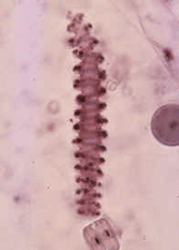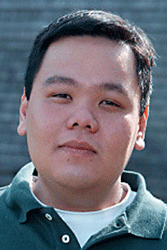Stemming Red Tide
Air Date: Week of June 9, 2006

Vermiform stage of the Amoebophrya parasite after an emergence from the host. (Photo courtesy of: Smithsonian Environmental Research Center)
Red tide hits the world’s coasts every year when toxic algae bloom offshore and are swept into coastal waters. But there’s a parasite that destroys red tide algae and could one day be used to fend off the toxic blooms. Living on Earth’s Ashley Ahearn reports.
Transcript
CURWOOD: If you’re fond of eating clams and oysters, you probably don’t like the paralytic shellfish poisoning that’s caused by Red Tide, a seasonal bloom of algae. Along the Eastern seaboard of the US, the Alexandrium Fundyense algae is the culprit, and can cost shell-fishermen millions in lost revenue. But it might not for long. Scientists at the Woods Hole Oceanographic Institute are developing possible solutions to kill off future red tides. Living on Earth’s Ashley Ahearn reports.
AHEARN: In warm, sunny summer waters off the East Coast, life is good for the Alexandrium Algae. The single celled organisms float near the surface, photosynthesizing and multiplying like there’s no tomorrow. But there’s one critter that can take all the fun out of being a free swimming Alexandrium.
SENGCO: I saw these little green bodies inside the red tide-causing organism Alexandrium, and on closer inspection it turned out to be this parasite that is found in Alexandrium.
AHEARN: Mario Sengco was a PhD student at the Woods Hole Oceanographic Institute when he came across Alexandrium algae’s worst nightmare, the Amoebophrya parasite.

Vermiform stage of the Amoebophrya parasite after an emergence from the host. (Photo courtesy of: Smithsonian Environmental Research Center)
AHEARN: The parasites take control of a healthy Alexandrium cell and drag it down into darker waters. Then, the parasites suck nutrients from their weakened host and get ready to make their exit in search of new prey.
SENGCO: In one corner of the host peeps out this thing. It’s this very long chain of cells that has little flagella on its side that’s swimming, pushing, trying to come out of it’s host, and then it breaks off from it’s host and starts to swim away, wiggle away. And what’s left is the empty husk or shell of the host.
AHEARN: When Mario Sengco realized that he’d found a natural predator of the poisonous red tide algae, he knew there was more to be learned about this little pest.
SENGCO: So our first big question is: what is the role of this parasite in the population dynamics of its host, Alexandrium?
[MOTOR BOAT SOUND]
AHEARN: That’s where Dave Kulis comes in. Kulis is a senior research assistant at the Woods Hole Oceanographic Institute, and today he’s collecting samples from three spots on Salt Pond. Salt Pond is a small, tidal pond on Cape Cod that serves as a microcosm of the Alexandrium algae’s life cycle in the open ocean.
[BOAT ENGINE IDLING DOWN “We’re good here”. ENGINE CUTTING OUT]
KULIS: This is an integrated sample. We’ve got this two-meter long PVC pipe and we can close it off on the top end and capture a two-meter column of water.
AHEARN: Kulis sticks the long PVC straw into the water to get a general measure of the amount of Alexandrium and parasites in the pond. At our next site, the sampling gets more specific.
[PUMP SOUNDS]
KULIS: So what we’re going to do here is we’re going to pump water at discrete depths from the bottom up to the surface.
AHEARN: The samples tell the scientists how both healthy and parasite-infected Alexandrium cells move around. This is how they found out that the infected Alexandrium cells sink before splitting open to release their parasitic invaders. But there’s a missing link in what scientists like Mario Sengco know about the lifecycle of the amoebophyra parasite.

Woods Hole researcher Mario Sengco (Photo: Tom Kleindinst)
AHEARN: When nutrients run out after the big snowmelts in the spring are flushed out to sea, Alexandrium algae cells stops dividing and instead start to form cysts, fertile little red tide time capsules, that sink to the bottom, and wait it out for fresh nutrients the following spring.
SENGCO: So we collected samples on the bottom of Salt Pond to look at the cysts being produced by the Alexandrium host and tried to see if we could find parasites within them.
AHEARN: When parasites infect Alexandrium in the pre-cyst phase, they stop the algae cells from dividing. So Sengco has a hunch that if the parasites get into the Alexandrium cysts, they’ll make them infertile as well, preventing further red tide blooms.
Even though Sengco may have discovered a natural birth control for red tide, he’s not advising dumping extra parasites into the ocean anytime soon. But he says that in learning more about red tide’s killer, we can learn more about red tide itself.
SENGCO: We focus a lot on how blooms begin, but there are not many studies that focus on how blooms end. We have to understand how these parasites can contribute to the decline of blooms, or how long a bloom persists in nature, from a biological perspective.
AHEARN: For Living on Earth, I’m Ashley Ahearn in Eastham, Massachusetts.
Links
For more information on predictions for this year's red tide bloom go to:
Living on Earth wants to hear from you!
Living on Earth
62 Calef Highway, Suite 212
Lee, NH 03861
Telephone: 617-287-4121
E-mail: comments@loe.org
Newsletter [Click here]
Donate to Living on Earth!
Living on Earth is an independent media program and relies entirely on contributions from listeners and institutions supporting public service. Please donate now to preserve an independent environmental voice.
NewsletterLiving on Earth offers a weekly delivery of the show's rundown to your mailbox. Sign up for our newsletter today!
 Sailors For The Sea: Be the change you want to sea.
Sailors For The Sea: Be the change you want to sea.
 The Grantham Foundation for the Protection of the Environment: Committed to protecting and improving the health of the global environment.
The Grantham Foundation for the Protection of the Environment: Committed to protecting and improving the health of the global environment.
 Contribute to Living on Earth and receive, as our gift to you, an archival print of one of Mark Seth Lender's extraordinary wildlife photographs. Follow the link to see Mark's current collection of photographs.
Contribute to Living on Earth and receive, as our gift to you, an archival print of one of Mark Seth Lender's extraordinary wildlife photographs. Follow the link to see Mark's current collection of photographs.
 Buy a signed copy of Mark Seth Lender's book Smeagull the Seagull & support Living on Earth
Buy a signed copy of Mark Seth Lender's book Smeagull the Seagull & support Living on Earth

